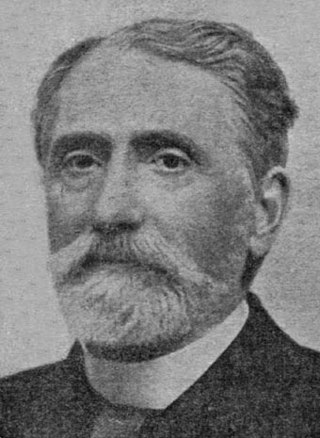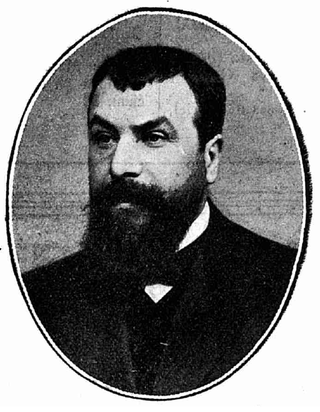| |||||
| Decades: | |||||
|---|---|---|---|---|---|
| See also: | |||||
Events from the year 1934 in Romania. The year saw the country sign the Balkan Pact.
| |||||
| Decades: | |||||
|---|---|---|---|---|---|
| See also: | |||||
Events from the year 1934 in Romania. The year saw the country sign the Balkan Pact.

Mihai Stelescu was a Romanian political activist.

Gheorghe (George) I. Brătianu was a Romanian politician and historian. A member of the Brătianu family and initially affiliated with the National Liberal Party, he broke away from the movement to create and lead the National Liberal Party-Brătianu. A history professor at the universities of Iași and Bucharest, he was elected titular member of the Romanian Academy. Arrested by the Communist authorities in 1950, he died at the notorious Sighet Prison.

Ion Alion Buzdugan was a Bessarabian-Romanian poet, folklorist, and politician. A young schoolteacher in the Russian Empire by 1908, he wrote poetry and collected folklore emphasizing Bessarabia's links with Romania, and associated with various founding figures of the Romanian nationalist movement, beginning with Ion Pelivan. Buzdugan was a far-left figure during the February Revolution, but eventually rallied with the National Moldavian Party in opposition to the socialists and the Bolsheviks. He vehemently supported the union of Bessarabia with Romania during the existence of an independent Moldavian Democratic Republic, and, as a member of its legislature, worked to bring it about. Threatened by the Bolsheviks, he fled to Romania and returned with an expeditionary corps headed by General Ernest Broșteanu, being one of the delegates who voted for the union, and one of dignitaries who signed its proclamation.

Alexandrina "Didina" Cantacuzino was a Romanian political activist, philanthropist and diplomat, one of her country's leading feminists in the 1920s and 1930s. A leader of the National Council of Romanian Women and the Association of Romanian Women, she served as Vice President of the International Council of Women, representing the International Alliance of Women, as well as Romania, to the League of Nations. However, her feminist beliefs and international profile clashed with her national conservatism, her support for eugenics, and eventually her conversion to fascism.

Alexandru C. "Alecu" Constantinescu was a Romanian politician.

Matei Basarab National College is a high school in Bucharest, Romania, located at 32 Matei Basarab Street, Sector 3. It opened in November 1860, one of two secondary schools to open that year in the Romanian capital, the other being Gheorghe Lazăr Gymnasium, in order to supplement the older Saint Sava High School.

Nicolae Gane was a Moldavian, later Romanian prose writer, poet and politician.

Vasile G. Morțun was a Romanian politician, playwright and prose writer.
Vlaicu Victor Virgil Bârna was an Austro-Hungarian-born Romanian poet.

Romanian Revival architecture is an architectural style that has appeared in the late 19th century in Romanian Art Nouveau, initially being the result of the attempts of finding a specific Romanian architectural style. The attempts are mainly due to the architects Ion Mincu (1852–1912), and Ion N. Socolescu (1856–1924). The peak of the style was the interwar period. The style was a national reaction after the domination of French-inspired Classicist Eclecticism. Apart from foreign influences, the contribution of Romanian architects, who reinvented the tradition, creating, at the same time, an original style, is manifesting more and more strongly. Ion Mincu and his successors, Grigore Cerchez, Cristofi Cerchez, Petre Antonescu, or Nicolae Ghica-Budești declared themselves for a modern architecture, with Romanian specific, based on theses such as those formulated by Alexandru Odobescu around 1870:
"Study the remains – no matter how small – of the artistic production of the past and make them the source of a great art (...) do not miss any opportunity to use the artistic elements presented by the Romanian monuments left over from old times; but transform them, change them, develop them ..."

Gheorghe Cantacuzino-Grănicerul was a Romanian landowner, general, and far-right politician who was a member of the Iron Guard, and a member of the Legionary Senate.

The National College is a high school located at 4 Arcu Street, Iași, Romania.
Events from the year 1944 in Romania. The year was dominated by the Second World War. The year started with the Soviet Army assault on Romanian troops and the Battle of Romania. King Michael led a coup d'état during the year and Romania left the Axis powers and joined the Allies. The Romanian army subsequently won victories against German and Hungarian troops.
Events from the year 1947 in Romania. The year saw the abdication of Michael I of Romania and foundation of the Romanian People's Republic.
Events from the year 1935 in Romania. The year saw the foundation of the Romanian Academy of Sciences.
Events from the year 1932 in Romania. The year saw the birth of two future Woman Grandmasters, Maria Albuleț and Margareta Teodorescu.
Events from the year 1927 in Romania. The year was marked by the death of King Ferdinand and the ascension of King Michael I. The year also saw the further development of the Polish–Romanian alliance and the start of the rise of the Iron Guard.
Events from the year 1923 in Romania. The year saw the country adopt a new constitution.
Events from the year 1881 in Romania. The year saw the end of the United Principalities of Moldavia and Wallachia and the creation of the Kingdom of Romania.